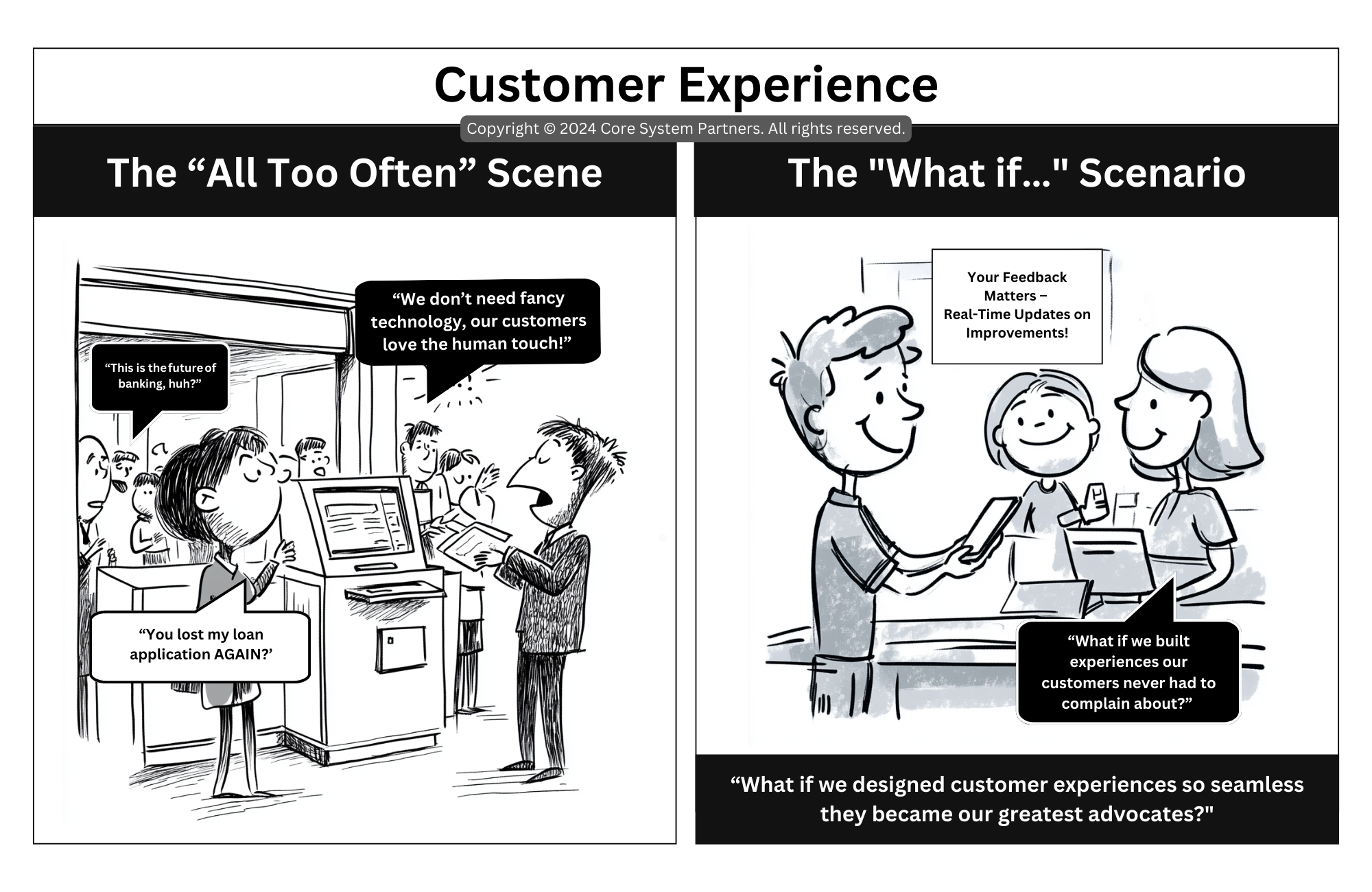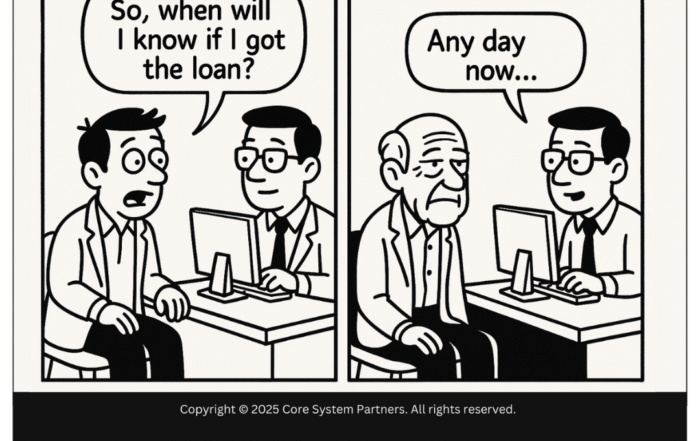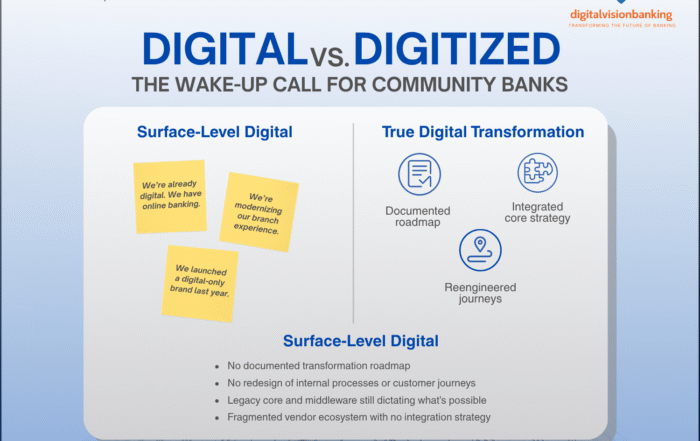
From complaints to compliments—see how banks can turn customer frustration into loyalty by blending the human touch with smart, seamless technology.
Customer experience is at the heart of banking. It’s the moment of truth when your processes, technology, and people come together to meet customer needs—or fail to. In “The All Too Often” Scene, a frustrated customer confronts a bank representative: “You lost my loan application AGAIN?” Meanwhile, a manager dismissively proclaims, “We don’t need fancy technology, our customers love the human touch!” The chaos and inefficiency in this scene highlight the consequences of unstructured responsibilities and outdated processes.
Now imagine “The What If…” Scenario. Customers interact seamlessly with staff using real-time updates and transparent processes. One customer smiles, remarking, “What if we built experiences our customers never had to complain about?” This transformation—moving from reactive problem-solving to proactive customer advocacy—illustrates the power of a coordinated team approach.
The Hidden Costs of a Frustrating Customer Experience
When processes lack coordination, customers suffer. Delayed responses, lost information, and inconsistent service erode trust and loyalty. And it’s not just customers who feel the pain—employees struggle too, caught between unhappy clients and broken systems.
What Happens in “The All Too Often” Scene?
- Unstructured Processes: Poorly designed workflows lead to lost documents, miscommunication, and endless frustration.
- Outdated Technology: Resistance to modernization limits efficiency and creates bottlenecks in customer interactions.
- Low Employee Morale: Staff members feel overwhelmed by manual tasks and unhappy customers, reducing their ability to deliver exceptional service.
I’ve seen teams trapped in these cycles, spending more time apologizing to customers than solving their problems. It’s a lose-lose situation for everyone involved.
The Power of a Coordinated Customer Experience Strategy
Contrast this with “The What If…” Scenario. Here, customers and employees benefit from streamlined processes, modern technology, and a clear focus on delivering seamless experiences. The result? Happier customers, empowered employees, and a stronger brand reputation.
What Makes Coordination Work?
- Integrated Systems: Technology enables real-time updates and eliminates the silos that cause delays and errors.
- Clear Responsibilities: Employees know their roles, ensuring smooth handoffs and consistent service.
- Customer-Centric Design: Processes are built around customer needs, making every interaction intuitive and efficient.
This approach doesn’t just solve problems—it builds loyalty. Customers become advocates, sharing their positive experiences with others and strengthening the bank’s reputation.
Steps to Build a Seamless Customer Experience
Transforming your customer experience requires a strategic focus on people, processes, and technology. Here’s how to make it happen:
1. Map the Customer Journey
Start by understanding your customers’ needs and pain points. Identify key touchpoints and evaluate how well your current processes support them.
- Example: Use customer journey mapping to visualize the loan application process, from initial inquiry to final approval. Highlight areas where delays or confusion occur.
2. Invest in Modern Technology
Upgrade outdated systems to provide real-time updates, automate routine tasks, and integrate customer data. Technology should enhance the human touch, not replace it.
- Example: Implement a CRM system that tracks customer interactions across channels, ensuring consistent and personalized service.
3. Empower Employees
Provide your team with the tools, training, and autonomy they need to deliver excellent service. When employees feel supported, they’re better equipped to support customers.
- Example: Offer training sessions on using new technology and handling common customer concerns with empathy and efficiency.
4. Simplify Processes
Eliminate unnecessary steps and streamline workflows to make it easier for customers to achieve their goals.
- Example: Reduce the number of forms required for a loan application and enable digital submissions to speed up the process.
5. Gather and Act on Feedback
Regularly collect feedback from customers and employees to identify areas for improvement. Use this feedback to iterate on processes and policies.
- Example: Introduce a feedback portal where customers can share their experiences, and dedicate a team to review and act on their suggestions.
The Benefits of a Seamless Customer Experience
A well-designed customer experience doesn’t just satisfy—it delights. The benefits extend far beyond individual interactions, driving long-term success for the bank.
1. Increased Customer Loyalty
Happy customers are more likely to stay with your bank, recommend your services, and expand their relationships with you.
2. Enhanced Employee Satisfaction
When employees have the tools and support they need, their morale improves, reducing turnover and increasing productivity.
3. Stronger Brand Reputation
Exceptional experiences create advocates who share their stories, attracting new customers and strengthening your competitive position.
4. Higher Efficiency
Streamlined processes save time and resources, allowing your team to focus on delivering value rather than fixing problems.
In my experience, the banks that excel at customer experience view it not as a department, but as a shared responsibility across the organization. It’s a mindset, not a checkbox.
From Frustration to Advocacy
In core banking, customer experience isn’t just a nice-to-have—it’s a critical differentiator. The difference between “The All Too Often” Scene and “The What If…” Scenario is clear: one frustrates customers, while the other turns them into advocates.
So, ask yourself: Are we reacting to customer complaints, or are we building experiences so seamless that customers never have to complain? By mapping journeys, modernizing technology, empowering employees, and simplifying processes, banks can create customer experiences that drive loyalty, advocacy, and growth.
Let’s stop apologizing and start delighting. Because when you put customers first, everyone wins.
#CoreBankingTransformation #CoreBankingReadiness





